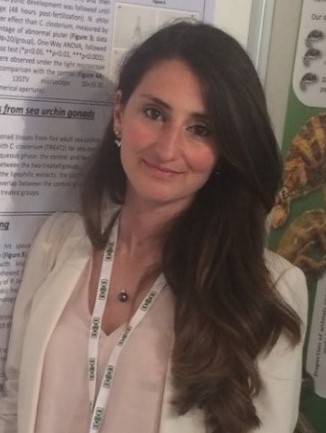 Researcher
Researcher
Stazione Zoologica Anton Dohrn
Calabria Marine Centre – CRIMAC
Ecosustainable Marine Biotechnology (BLUBIO)
C.da Torre Spaccata, Località Torre Spaccata, 87071 Amendolara – Italia
Tel.: 3491795809
E-mail: nadia.ruocco(at)szn.it
Research Interests
My research interests focus on marine biotechnology, ecotoxicology and molecular ecology. Marine natural products (MNPs) are very interesting for their ecological and biotechnological value. In fact, MNPs possess several biological activities, such as anti-cancer, anti-bacterial, anti-viral, antifungal, anti-oxidant and anti-aging, that are useful for pharmaceutical, nutraceutical and cosmeceutical purposes. I am interested in MNPs from marine invertebrates and their symbionts by applying molecular approaches, such as, metagenomics, transcriptomics and genetic engineering. For instance, metagenomic approaches are able to predict classifiable secondary metabolite biosynthetic gene clusters (BGCs), synthetizing various secondary metabolites such as, terpenes, polyketides, bacteriocins and nonribosomal peptides. It is well known that a conspicuous amount of bioactive secondary metabolites is synthetized by the symbiotic community living within marine invertebrates. This strict association is often fundamental for the survival and fitness of both organisms. The number of natural products discovered from marine microorganisms has sharply increased over the past decade. This reservoir of bioactive microbes offers exciting alternatives to the often unprofitable and complicated chemical synthesis of natural products, and the unsustainable harvest of slow-growing and declining wild populations.
I am also interested in ecotoxicological studies evaluating the stress response of marine invertebrates to diverse natural and anthropogenic-related compounds. Experimental pipelines principally include gene expression analyses and transcriptomics to measure the number of Differentially Expressed (DE) genes in control and treated samples, identification of the molecular pathway activated in response to the exposure of such stressors and validation of the biological cascade at the protein level through biochemical approaches.
Publications
1) Ruocco, N., Costantini, S., Zupo, V., Lauritano, C., Caramiello, D., Ianora, A., Budillon, A., Romano, G., Nuzzo, G., D’Ippolito, G., Fontana, A., Costantini, M. (2018a) Toxigenic effects of two benthic diatoms upon grazing activity of the sea urchin: morphological, metabolomic and de novo transcriptomic analysis. Scientific Reports 8, 5622.
2) Ruocco, N., Annunziata, C., Ianora, A., Libralato, G., Manfra, L., Costantini, S., Costantini, M. (2019a) Toxicity of diatom-derived polyunsaturated aldehyde mixtures on sea urchin Paracentrotus lividus development. Scientific Reports 9, 517.
3) Ruocco, N., Cavaccini, V., Caramiello, D., Ianora, A., Fontana, A., Zupo, V., Costantini, M. (2019b) Noxious effects of the benthic diatoms Cocconeis scutellum and Diploneis sp. on sea urchin development: Morphological and de novo transcriptomic analysis. Harmful Algae 86, 64-73.
4) Mutalipassi, M., Mazzella, V., Romano, G., Ruocco, N., Costantini, M., Glaviano, F., Zupo, V. (2019) Growth and toxicity of Halomicronema metazoicum (Cyanoprokaryota, Cyanophyta) at different conditions of light, salinity and temperature. Biology Open 8, bio043604.
5) Morroni, L., Sartori, D., Costantini, M., Genovesi, L., Magliocco, T., Ruocco, N., Buttino, I. (2019) First molecular evidence of the toxicogenetic effects of copper on sea urchin Paracentrotus lividus embryo development. Water Research 160, 415-423.
6) Ruocco, N., Nuzzo, G., d’Ippolito, G., Manzo, E., Sardo, A., Ianora, A., Romano, G., Iuliano, A., Zupo, V., Costantini, M., Fontana, A. (2020a) Lipoxygenase pathways in diatoms: occurrence and correlation with grazer toxicity in four benthic species. Marine Drugs 18, 66.
7) Ruocco, N., Bertocci, I., Munari, M., Musco, L., Caramiello, D., Danovaro, R., Zupo, V., Costantini, M. (2020b) Morphological and molecular responses of the sea urchin Paracentrotus lividus to highly contaminated marine sediments: The case study of Bagnoli-Coroglio brownfield (Mediterranean Sea). Marine Environmental Research 154, 104865.
8) Ruocco, N., Albarano, L., Esposito, R., Zupo, V., Costantini, M., Ianora, A. (2020c) Multiple roles of diatom-derived oxylipins within marine environments and their potential biotechnological applications. Marine Drugs 18, 342
9) Ruocco, N., Esposito, R., Bertolino, M., Zazo, G., Sonnessa, M., Andreani, F., Coppola, D., Giordano, D., Nuzzo, G., Lauritano, C., Fontana, A., Ianora, A., Verde, C., Costantini, M. (2021) A metataxonomic approach reveals diversified bacterial communities in Antarctic sponges. Marine Drugs 19, 173.
10) Glaviano, F., Ruocco, N., Somma, E., De Rosa, G., Catapani, V., Ametrano, P., Caramiello, D., Costantini, M., Zupo, V. (2021) Two benthic diatoms, Nanofrustulum shiloi and Striatella unipunctata, encapsulated in alginate beads, influence the reproductive efficiency of Paracentrotus lividus by modulating the gene expression. Marine Drugs 19, 230.
11) Esposito, R., Ruocco, N., Viel, T., Federico, S., Zupo, V., Costantini, M. (2021) Sponges and their symbionts as a source of valuable compounds in cosmeceutical field. Marine drugs 19, 444.










